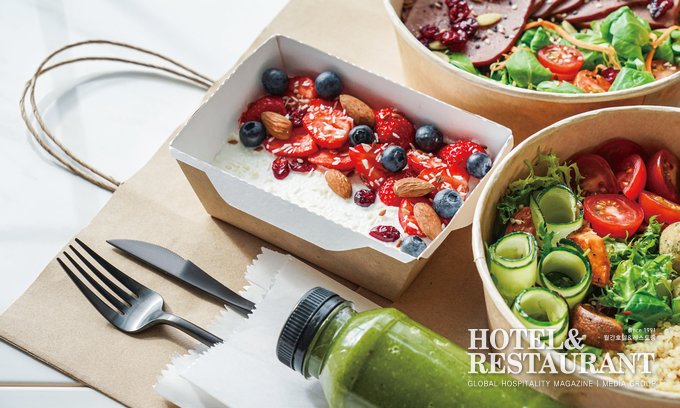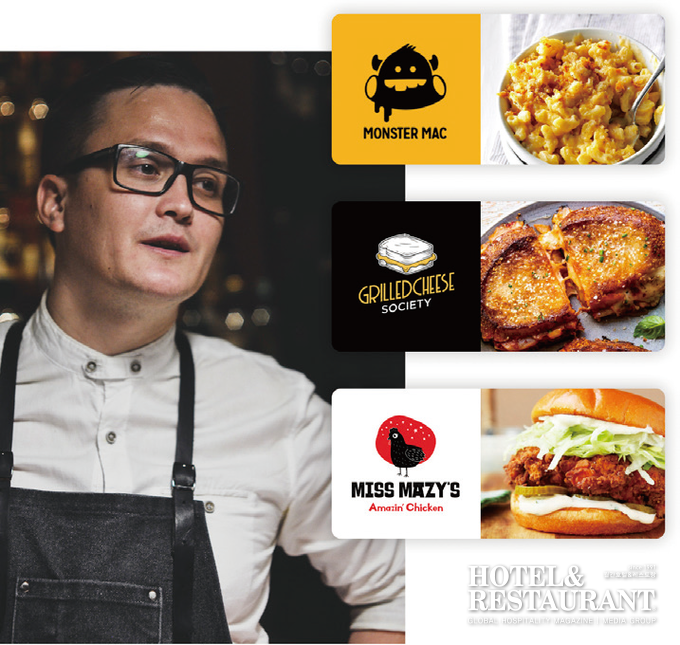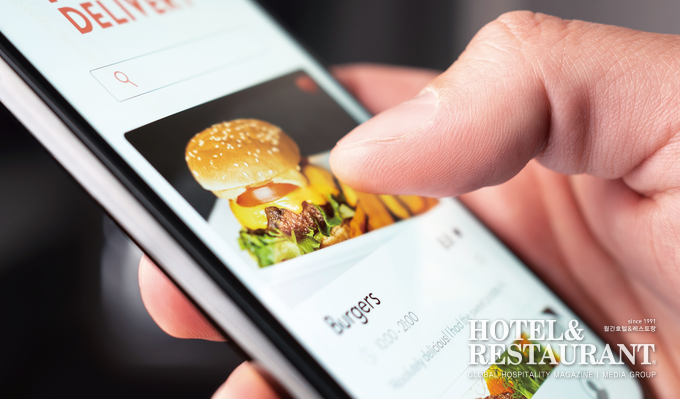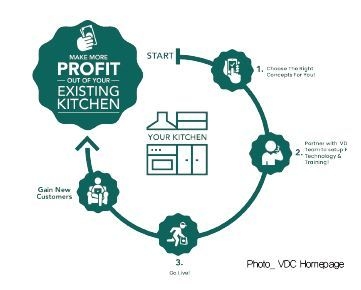
최근 실존하지 않는 ‘가상 브랜드(Virtual Brand)’들의 뉴스가 심심치 않게 들려오고 있다. 코로나19는 레스토랑, 호텔, 케이터링 기업, 심지어는 병원까지 막대한 잉여 주방 공간을 만들어냈다. 그러나 이는 사실 미국이나 영국과 같은 국가들에게 어제 오늘의 일이 아니다. 저금리 환경과 글로벌 저축 과잉으로 매장 확장을 위한 레스토랑의 자금이 충분한 탓에 전체적으로 풀 서비스 레스토랑의 공급이 넘쳐났기 때문이다.
코로나19로 탄생한 가상 브랜드의 전망을 살펴보려면 먼저 ‘가상 브랜드’의 개념을 명확히 짚고 넘어가볼 필요가 있다. 가상 브랜드는 쉽게 말해 배달 서비스를 기반으로 하기 때문에 메뉴가 제한된 레스토랑 브랜드거나, 배달만을 위해 개발된 단일 메뉴 브랜드다. 우리가 흔히 레스토랑하면 떠오르는 단독 건물 매장이나 식사를 위한 물리적인 공간은 존재하지 않는다. 이는 스마트폰과 고속 광대역의 개발이 없었으면 생기지 못했을 개념이다. 가장 대표적인 미국의 사례를 통해 더 자세히 접근해보자.

코로나19와 기존 레스토랑 과잉 경쟁의 구조로 프랜차이즈, 독립 브랜드 할 것 없이 많은 레스토랑이 가상 브랜드로 돌파구를 찾으려 하고 있다. 하지만 결과는 어떤가? 혹 임대료나 기타 운영 비용을 충당하기 위해 현금 운용을 늘리면서 필요 이상으로 많은 출혈을 하고 있는 것은 아닌가? 아니면 소득 없이 과도한 노동력 낭비를 하고 있지는 않은지, 가상 브랜드의 효용성에 대해서는 아직까지 업계 의견이 다소 엇갈리고 있는 상황이다.
‘Nextbite’는 로스앤젤레스의 3대 유대인 델리 오너 Alex Cantor에 의해 시작됐다. 그가 처음으로 운영한 소프트웨어 기업 ‘Ordermark’는 배달 업체를 이용하는 레스토랑 그룹에 운영 솔루션을 제공했다. 기존 레스토랑 구조는 하나의 주방에 여러 브랜드를 론칭 했기 때문에 한 곳에 3~4대의 주문 태블릿을 갖춰야 해 효율적이지 못했는데, Ordermark는 모든 태블릿을 하나의 태블릿, 또는 POS에 직접 통합하는 소프트웨어 솔루션을 제안한 것이다. Ordermark 솔루션은 효용성 높은 서비스에 코로나19 여파까지 더해져 곧 수천 개의 레스토랑이 이용하게 됐다. 이에 Alex는 Ordermark 소프트웨어의 잠재적 가능성이 높다고 판단, 그가 셰프들과 함께 개발했던 가상 브랜드와 페어링해 사업 영역을 넓혀나갔다. 그리곤 Ordermark의 솔루션 수수료는 그다지 저렴하지 않은 편이었는데 입점 레스토랑에서 그의 브랜드를 사용할 경우 소프트웨어를 무료로 제공해 베네핏을 줬다. 기존 레스토랑은 대개 하나 혹은 그 이상의 브랜드 매출에 40~50%의 수수료로 그들의 차별화 포인트를 유지해왔다. 대신 40~50%에는 30~35% 정도의 배달 수수료가 포함돼 있는 구조였다. 이 모델은 기본적으로 식재료와 레스토랑 운영에 따른 추가 소모비용이 없고, 메뉴 자체의 마진이 매우 높은 경우에만 효과적으로 작동하는 구조다. 최근 소프트뱅크가 1억 2000만 달러의 시리즈 C 펀딩을 통해 큰 기회를 본 것도 이와 같은 메커니즘이다.
Nextbite의 가상 브랜드에는 Grilled Cheese Society, Miss Mazy’s Amazin’ Chicken, Firebelly Wings와 같은 것들이 있다. 각 브랜드는 호스트 주방과 공유되는 자체 브랜딩 레시피를 가지고 있고, 같은 거래 지역의 배달 앱에 노출되며 주문은 주방에서 원활하게 진행된다.
한편 흥미로운 또 다른 가상 브랜드로 VDC(Virtual Dining Concepts)가 있다. VDC는 할리우드 영화 테마의 레스토랑으로 유명한 Planet Hollywood의 창시자이자 오랜 기간 호스피탈리티업계에서 업적을 이어오고 있는 Robert Earl에 의해 론칭됐다. VDC는 프라이드 치킨, 버거와 같이 보통의 평범한 패스트푸드 메뉴에 유명인들의 이름을 부여, 직관적인 브랜드 인지도 구축을 통해 배달 앱에 진출했다.
인기 메뉴로는 Mr. Beast Burger, Mariah’s Cookies, Tyga Bites가 있다. Mariah는 물론 가수 Mariah Carey고, Mr. Beast는 구독자 수 5500만 명을 기록하고 있는 유튜버, 그리고 Tyga는 유명 래퍼다. 유명인들의 유명세를 등에 업은 메뉴들은 상당한 파급력을 자랑한다. 실제로 Mr. Beast Burger는 홍보 목적의 팝업
스토어를 제외하고는 오프라인 소매점은 오픈할 계획 없이 올해 300개 호스트 주방으로 규모가 확장되고 있다. 또, 언론 보도에 따르면 가상 출시 3개월 만에 100만 개 이상의 버거가 판매됐다.
잘 알려진 호텔 및 레스토랑 그룹 sbe도 새로운 개념 ‘C3’, ‘Creating Culinary Communities’ 도입을 통해 ‘Ghost Kitchen(배달전문 음식점, 2020년 11월호 Joel의 Dining Market 참고)’과 가상 브랜드로 분화하고 있다. 현재 운영되고 있는 브랜드는 Sam’s Crispy Chicken, 초밥 레스토랑 체인인 Katsuya에서 영감을 얻은 Krispy Rice, 비건 채식 메뉴 시리즈 Plant Nation이있다. 그리고 이들 브랜드들은 모두 배달 서비스만을 기반으로하며, sbe 호텔에서 자체 생산해 배달하기도 한다.
이미 현재 미국에서는 10만 개가 넘는 가상 브랜드가 운영되고 있고, 이들 중 상당수는 시간에 지남에 따라 급격히 늘어난 양만큼 사라지는 브랜드들도 빠르게 증가할 것으로 예상된다. 너무 방대한 양의 브랜드가 노출되고 있기 때문에 고객의 관심을 끌어 단골을 만들고, 지속가능한 사업이 되기까지는 마치 일확천금의 기회를 노리는 것과도 같아 보인다. 프라이드 치킨, 피자, 버거, 치킨 윙과 같이 지극히도 평범하고 익숙한 메뉴들이얼마나 다양한 콘셉트로 특화될 수 있을까?
개인적인 의견으로 가상 브랜드에 대한 더 신중한 전략을 세우기 위해서는 준비와 배달 프로세스가 용이한 전문 기업에게 라이센스를 주는 형태를 취하는 것도 방법일 것 같다. Wow Bao와 Nathan’s Hot Dogs와 같은 브랜드가 다른 지역에서 라이센스를 받은 호스트 주방을 통해 미국의 한 지역에서 인기몰이를 하고 있는 가상 브랜드의 가장 대표적으로 좋은 사례다.
한국의 경우는 어떤가? 이러한 가상 브랜드 모델이 잠재적 파급력을 보일 수 있는 시장이 조성되고 있나? 확실히 코로나19 이후 한국에서 폭발적으로 성장한 배달 시장만 보더라도 가상 브랜드 비즈니스 가능성이 엿보이는 것 같아 보인다. 그렇다면 호스트 주방을 지원하기 위해 주방 시설은 충분히 확보돼 있는지 생각해봐야 한다. 한국의 전체 레스토랑 규모는 미국에 비해 상당히 작은 편이기 때문에 현재 레스토랑 운영에 애로사항을 겪고 있는 호텔이 하나의 대안이 될 수도 있을 것이다. 따라서 가상 브랜드에 대해 사업 계획을 세우고 있는 이들은 이 부분에 대한 많은 연구가 필요하다.
코로나19는 전 세계적으로 환대산업을 흔들어 놓았으며 시장은 이미 혼란스럽기 그지없다. 이에 일본과 다른 아시아 시장과 비교해 한국에서는 어떻게 이 난관을 타개해나갈 수 있을지 기대가 된다. 더 큰 난관들이 예상되지만 한국 외식 기업들의 포스트 코로나 외식 시장에 대한 혜안을 바라본다.
|
Are Virtual Brands A Good Idea?

Virtual brands are all in the news these days. Covid-19 has created enormous underutilized kitchen capacity for restaurants, hotels, catering companies and even hospitals. To be fair, countries like the USA and the UK have suffered from this phenomenon for the past several years due to an oversupply of full-service restaurants overall. There was simply too much money available to restaurants for store expansions given the low interest rate environment and the global savings glut.
So many restaurants both chain and independent are experimenting with virtual brands but are they getting results? In short, are they using up excess capacity while gaining incremental cash flow to cover their rent and other operating costs or just working longer hours with no benefits? The answer so far is mixed.
First, what exactly are virtual brands? The easiest explanation is that these are restaurant brands with limited menus or single menu brands that have been developed expressly for third party delivery apps. They do not exist in the physical world of brick and motor retail. These concepts would not exist without the development of smart phones and high-speed broadband. Let’s review a few of the virtual brand groups in the USA to better understand what they are doing.
Nextbite was started by Alex Cantor, a third-generation Jewish deli owner in Los Angeles. He first started a software company, Ordermark, which provided a solution to restaurant groups that were using the third-party delivery companies. Each company required a different tablet for order receipts so it was not unusual to see a restaurant with 3 or 4 different tablets in the kitchen to receive these orders. Ordermark provided a software solution to integrate all the tablets into one tablet or the POS directly. Soon, thousands of restaurants were using the Ordermark solution. Alex then saw the potential to develop Ordermark further by pairing it with virtual brands he developed with chefs. He basically gave the Ordermark software for free if restaurants would take some of his virtual brands. The fees were not cheap. A restaurant basically paid Nextbite up to 40-50% of sales for one or more brands and kept the difference for itself. Nexbite’s fee covered the cost of its commission and the third-party delivery fees which are in the range of 30-35% for independent restaurants. This model can only work if there are no incremental costs beyond basic food & paper and the menu items themselves must have very high gross margins. Certainly, Softbank saw a great opportunity because they recently led a $120 Million Series C funding for the company.
Nextbite offers a wide variety of virtual brands such as Grilled Cheese Society, Miss Mazy’s Amazin’ Chicken, and Firebelly Wings for example. Each has its own branding and recipe which is shared with the host kitchen. The brands appear on all the third-party apps in the same trade areas and orders are received
Some popular menu items are Mr. Beast Burger, Mariah’s Cookies, and Tyga Bites. Mariah is of course Mariah Carey the singer, and Mr. Beast is a YouTube sensation with over 55 million subscribers, yes 55 million! Tyga is a well-known rapper. Mr. Beast Burger is expanding to 300 host kitchens this year and there are no plans to add any brick and mortar retail except perhaps as a pop-up for publicity purposes. According to press reports over 1 million Mr. Beast burgers have been sold in the first three months of the virtual launch.
The well-known hotel and restaurant group, sbe, is also getting into the ghost kitchen and virtual brand space with their new C3 concept or “Creating Culinary Communities.” These are planned as a number of ghost kitchens featuring new virtual brands developed in collaboration with several leading chefs. Examples of the concepts being featured are Sam’s Crispy Chicken, Krispy Rice (a take on sushi from their restaurant chain, Katsuya), and Plant Nation, a series of vegan menu offerings. Again, these are delivery only concepts that can also be produced at the sbe hotels as well.
It is estimated that there are already over 100,000 virtual brands operating in the USA currently so it is expected that many of these will wash out quickly over time. To some extent this is like playing a lottery to see which concepts will catch on with customers and eventually survive and prosper. After all, how many virtual concepts can succeed in the same popular categories of fried chicken, pizza, burgers and chicken wings?
In my view a far more prudent strategy is for host kitchens to license known entities that are easy to prepare and easy to deliver. Wow Bao and Nathan’s Hot Dogs are good examples of established brands from one region of the USA getting tractions through host kitchen licensed in other regions.
Is there a large potential market in Korea for virtual brands? Certainly, the popularity of third-party delivery apps seems to suggest that a business opportunity does exist. However, are there a large number of restaurants with excess kitchen capacity to support the host kitchen model? Restaurants in Korea tend to be fairly small compared to the USA, but hotels may be a better option. I think this will take more study by entrepreneurs looking to enter the field.
Covid-19 has certainly shaken up the hospitality industry globally and the space is ripe for disruption. It will be interesting to see what forms the disruption will take in Korea compared to Japan and other Asian markets. But more disruption will certainly come! |
 Joel Silverstein Joel Silverstein
이스트웨스트 호스피탈리티 그룹 대표 현재 홍콩에 거주하며 최고 경영진과 포춘(Fortune) 500대 기업이 다수 아시아 국가에서 지속가능한 성장을 할 수 있게 도와주고 있다. |
- 2024.11.05(화)~2024.11.11(월) 투어리즘&마이스 서울특별시관광협회, 제27대 협회장 후보자 등록 실시
- 2024.10.25(금)~2024.11.07(목) 대회·공모전 "서울 관광산업 발전에 기여한 자를 찾습니다."…서울특별시관광협회(STA), 2024 서울관광대상 수상 후보자 모집
- 2024.10.18(금)~2024.10.19(토) 축제 한국관광공사, 원주 시민과 함께하는 ‘세계로(路) 페스타’개최
- 2024.10.13(일)~2024.10.20(일) 축제 하슬라국제예술제 오는 13일 개막… 공연장으로 탈바꿈한 강릉 정체성 담긴 장소들
- 2024.10.5(토)~2024.11.3(일) 축제 대한민국 대표 공연관광 축제 ‘2024 웰컴대학로’ 개최
- [Joel의 Global Dining Market] 로보틱스, 자동화의 시대가 도래하다 2021-06-15
- [Joel의 Global Dining Market] 뉴노멀에 적응하는 식당가들의 새로운 전략_ 배달음식 전문점 2020-11-12
- [Joel의 Global Dining Market] 해외 진출의 관문? 홍콩 시장의 인기_ 외식업계 위기와 변화 면밀히 살펴봐야 2020-09-20
- [Joel의 Global Dining Market] 코로나19의 여파, 미국 외식 산업의 위기_ 더 좋은 음식과 더 나은 서비스로 고객 공략해야 2020-08-03
- [Joel의 Global Dining Market] 코로나19로 기세 오른 플랫폼 비즈니스_ 레스토랑과 상생하는 모델 모색해야 2020-06-02
- [Joel의 Global Dining Market] 아픈 손가락의 성장 필리핀 2020-04-20
- [Joel의 Global Dining Market] 크로아티아 발칸 반도의 맛을 경험하다 2020-02-10
-

[손진호 교수의 와인 Pick] Louis Maurer
- 2024-11-16
- 손진호 칼럼니스트
-

(사)한국중찬문화교류협회, 시애틀서 한식·K-메디푸드 진수 선뵈
- 2024-11-15
- 서현진 기자
-

[GLOBAL NETWORKS] 푸꾸옥의 장기적인 발전 방향
- 2024-11-15
- 최성웅 칼럼니스트
-

그랜드 하얏트 서울, ‘윈터 온 아이스’ 아이스링크 룸 패키지 예약 오픈
- 2024-11-15
- 서현진 기자
-

에그드랍, 태국에 이어 필리핀 최고의 초대형 쇼핑몰에 ‘글로벌 신규 매장’ 오픈 예정
- 2024-11-15
- 호텔앤레스토랑
-

서울시관광협회, 서울 관광숙박업(호텔업) 종사자들의 안전 역량 강화에 앞장선다
- 2024-11-15
- 서현진 기자































